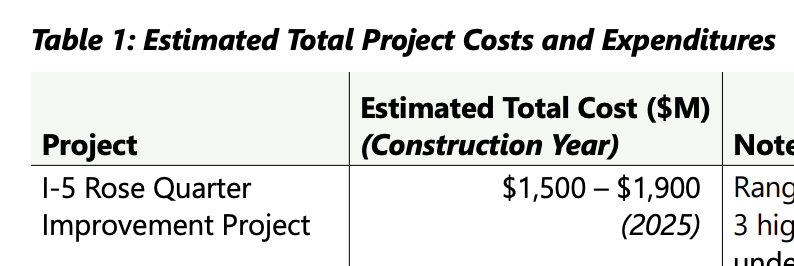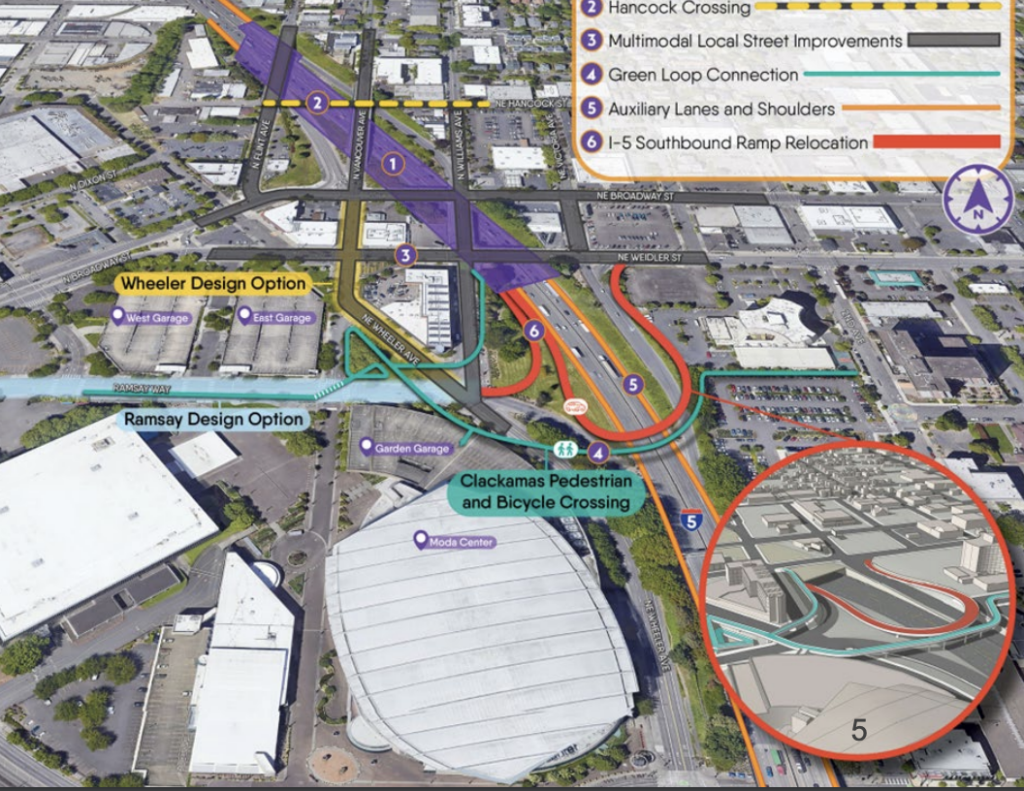The Oregon Department of Transportation is playing “Extend and Pretend” with the $1.9 billion I-5 Rose Quarter Freeway widening project
The cost of the 1.5 mile freeway widening has quadrupled from $450 million in 2017 to $1.9 billion today.
Meanwhile, the agency has diverted money earmarked for the Rose Quarter to other projects, and now faces a $1.35 to $1.75 billion financial hole.
Its finance plan has no concrete steps for paying for the project, aside from hoping for new sources of federal and state revenue.
“Extend and pretend” keeps $40 to $60 million flowing to consultants but doesn’t answer any of the hard questions about this fatally flawed project.
Rose Quarter freeway widening cost quadrupled to $1.9 billion
In May, Governor Tina Kotek called a time-out out highway tolling until 2026, and directed the Oregon Department of Transportation to come up with a comprehensive financial plan for its multi-billion dollar package of Portland area highway expansions. The ODOT plan revealed that the I-5 Rose Quarter project, originally approved by the Legislature in 2017 at an estimated cost of $450 million now has a price tag of $1.9 billion. Every year or so, ODOT has ratcheted up the cost of the Rose Quarter freeway widening. It was $450 million in 2017, $795 million in March 2020, $1.45 billion in September 2021, and now, $1.9 billion.
Further cost increases are likely
And it looks like they’re not done yet. The design for the Rose Quarter project is still very much in a state of flux. The original design was replaced by a “Hybrid 3” alternative, and last year, as part of a “Supplemental Environmental Assessment” ODOT revealed a new freeway exit design with a dangerous (and substandard) hairpin off-ramp. That design has produced widespread criticism from the City of Portland, and the Portland Trailblazers, who operate the Moda Center adjacent to the freeway exit. On June 27, ODOT for the first time revealed yet another re-design of the project, now with the second hairpin, this time on a flyover structure over the widened freeway.
ODOT’s latest financial plan is studiously ambiguous about whether the new cost estimates reflect the new flyover exit ramp. They divided their explanation of the Rose Quarter cost estimates between two different tables, as follows:
The notes to the first table say that the estimate reflects the “current Hybrid 3” design, and directs the reader to the second table to understand the “cost progression detail.” This term ought to make one nervous, given the half-life of ODOT cost estimates. The second table plainly signals that we will see yet another set of project cost estimates two years from now, when ODOT will be “updating the total project cost estimate to reflect the advanced design and outcomes of the environmental process.” Translated into English, this means, ODOT is planning yet another round of cost estimates in 2-3 years, and they will undoubtedly be higher than the current figures.
Available revenue: Almost nothing.
In reality, there is no finance plan. ODOT staff presented a 23-page document describing its current financial problems. Overall, the agency concedes that it is Portland area highway projects would cost $3.7 to $4.3 billion, and that the agency has only about $717 million for these projects—unless in is allowed to start levying tolls. The shortfall has already bled ODOT to effectively cancel plans for the I-205 Phase 2 freeway widening and the I-5 Boone Bridge at Wilsonville. This estimate also doesn’t include likely additional state funding that will be needed to complete the Interstate Bridge Replacement Project; Oregon’s $1 billion commitment is only a down payment toward the total $7.5 billion cost of that project.
This plan is designed to respond to Governor Kotek’s direction and answer key questions about how to pay for the UMS projects in both the short and long term.
It isn’t so much a plan as it is a description of the size of the hole that ODOT faces for the Rose Quarter. And the hole is huge: ODOT needs up to $140million in additional funds just to keep the project design going, and beyond that, a further $1.25 to $1.6 billion to actually construct something:
An additional $100 million to $140 million is needed to ready the project for construction, while an additional $1.25 to $1.6 billion is needed to complete construction of all work packages.
Where will that money come from? The document says it “could” come from any of a variety of sources:
- federal competitive grants (though it would be competing with other Oregon projects, notably the Interstate Bridge Replacement)
- new (as yet un-enacted) state funding.
- tolling as part of the regional mobility pricing program (which is still in development and years away).
- re-allocation of the STIP (i.e., taking money from other projects that ODOT has already committed to fund).
Even a casual glance shows this isn’t a plan at all. There’s no indication that even added together, all these sources could produce the needed $1.35 to $1.75 billion. Nor is there any indication of what will happen if they can’t find that total amount.
What the Oregon Transportation Commission approved at its June 28 meeting was spending an additional $40 to $60 million on the Rose Quarter project for consultants and planning, in order to bring the project to “30 percent design.” Beyond its hypothetical and speculative list of funding sources, ODOT has no actual plan to pay for construction. Consultants will keep getting paid; ODOT will keep beating the drum for the project, costs will continue to rise, and the decision on what the Rose Quarter will look like, and how it will be paid for, which has already dragged on for six years, will continue to drag on even longer.
ODOT’s strategy: Extend and pretend
In the banking world, this practice known as “extend and pretend.” When a bank makes a loan to a project that has gone bad, and for which the borrower can’t make repayment, rather than forcing the loan into default (and having to record a loss on the bank’s books), the bank gives the borrower more time to repay (amortizing the loan over say ten years, rather than five)—the extend part—and then revises its cash flow projections to show getting repaid—the pretend part). The bank’s current profits (and bonuses) are protected, and the can is kicked down the road, to be dealt with at another time.
That’s exactly what ODOT is doing with the I-5 Rose Quarter project: It’s extending the project’s timeline by at least two or three years, and its pretending that, during that time, someone will find at least $1.35 or $1.75 billion (and likely a good deal more) to pay for the project. “Its a very important project” all of the members of the OTC solemnly agree. Maybe so, but what this really signals is that the OTC is going to put off for several more years the question of whether this project is worth its growing cost. The Rose Quarter will be a zombie project, utterly un-funded, but technically not dead, because ODOT (and its enablers) pump millions into keeping it on life support.




